Assalam-u-alaikum wa rahmatullahi wa barakatuh,
I was going through the site 'islamic-awareness's 'islamic coins' section and noticed some important facts about the star-crescent emblem. For brothers and sisters who don't know about this, I hope it will be helpful Insh'Allah.
This emblem existed in the pre-islamic ages, specially during the sassanian empre it was widely used. When the Muslims conquered persia, sassanian empire ended but their coin containing the symbol and the face of sassanian emperor Yazdgrid three, WHO WAS A ZOROASTRIAN. Here is te coin's picture taken from
http://www.islamic-awareness.org/History/Islam/Coins/drachm30.html.
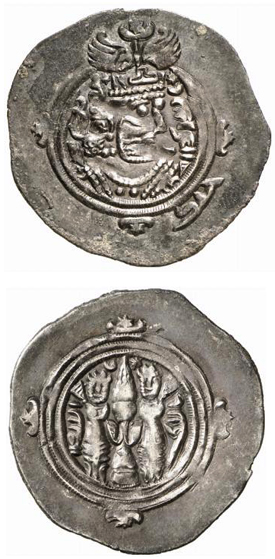
Notice the crescent and star symbol at the top of the emperor's head. The coin existed the same even after muslim conquest, though the governors inserted Allah's Holy Name in the coin. See the picture of the coin during the reign of the fifth caliph Muawiya ibn Abu Sufian (R).
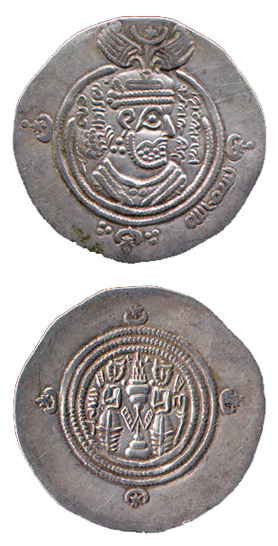
Look carefully. Do you see the writing-
Bism Allah (In the Name of God) in the right lower corner? But the crescent-star symbol and the pagan emperor's portrait are right in their places!
So a question rises here. How can Muawiya (R), a close companion of the Prophet SAW, allow this coin with a pagan symbol and someone's portrait which is strictly prohibited??
Personally I don't hate Muawiya (R) 'cause I'M NOT A SHIA OR A KHARIZI. In fact I don't like to criticize any of the Prophet's SAW companions. But I do admit he made some mistakes as he was also a human like others (we don't worship the sahabas as the trinitians worship the disciples). And so by the term 'KHULAFA-E-RASHIDIN' (Rightly guided caliphs) I and most people understand Abu bakr, Umar. Usman and Ali (R).
And while critisizing a close companion of the Prophet SAW, we must judge things logically and rationally. Muawiyah R couldn't change the coin in a blink of an eye even if he wanted to. Read the foloowing from
http://www.islamic-awareness.org/History/Islam/Coins/ and notice the bold writings.
After the Muslims defeated the armies of Byzantine and Sassanian empires, there came the need to administer the conquered territories. The early Muslim from Arabia did not have a sophisticated system like that of the two defeated empires. So, the best recourse for them was to maintain the existing administrative systems just like other conquerers before and after them did. However, the early Muslims inherited two different administrative systems from the conquered two empires. Hence they had to maintain two parallel administrative systems one in the east and another in the west, which differed in their languages, culture, monetary systems and controls. The Muslims maintained these parallel systems for over 50 years until the reforms of the Umayyad caliph al-Malik.
Before the reforms of al-Malik, the Muslims used the existing MONETARY SYSTEMS of their Sassanian and the Byzantine predecessors. There is a
debate concerning the earliest coinage and their dating. Some argue that Muslims started striking coinage almost immediately as they did in the former Sassanian domain. Other argue that the Muslims did not strike coins in the former Byzantine realms until the reign of al-Malik. However, the middle ground appears to be more appropriate as the the coinage of the era before the advent of al-Malik was very complex. At some point in time, both in the east and in the west, the Islamic empire started to make its presence known via the coins that circulated in their domains. Initially, the changes were very MINOR with the addition of short phrases in Arabic and/or the addition of hijra dates. These lasted until a complete reform of the administrative system by al-Malik who united it in Arabic and changed the coinage drastically to what we essentially call as ISLAMIC COINS.
It is not easy to suddenly change the coinage system of a vast empire, almost impossible.
But still, whoever inserted Allah's name in the coin could at least give the Name a place in the top AS I REALLY REALLY DON'T APPRECIATE/SUPPORT KEEPING A PAGAN SYMBOL ON THE TOP AND A PORTRAIT OF A ZOROASTRIAN EMPEROR IN THE MIDDLE WHILE THROWING OFF ALLAH'S NAME IN THE LOWER CORNER.
The coin of Abd al-Malik ibn AbdAllah, zubayrid governor of Bishapur, also had the name of the Prophet, (which is the earliest occurance of the name Muhammad in a dated Muslim text), but still in the lower left corner!! See yourselves.
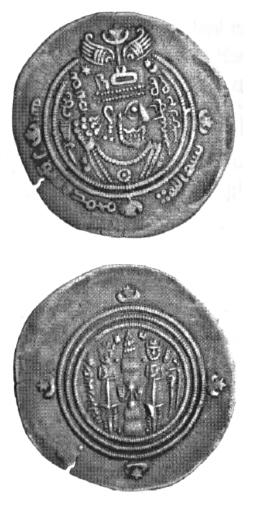 And brothers I think this is how the pagan emblem started to enter Islam slowly. Later the Turks adopted this symbol from the persians and finally it became a worldwide emblem for Islam.
And brothers I think this is how the pagan emblem started to enter Islam slowly. Later the Turks adopted this symbol from the persians and finally it became a worldwide emblem for Islam.Well in this case, thanks to Muawiya's (R) son Yazid (only for this reason, not for his other works!) as he removed Allah's name from the gathering of pagan marks! (ie the crescent-star symbol and the portrait) At least he didn't mix Allah's name with those things! This is his coin:
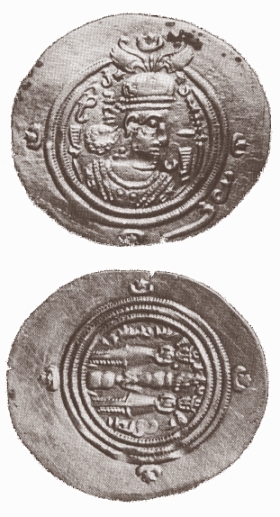
Finaly, umayyad caliph Abd al-Malik ibn Marwan completely removed the coin with the pagan symbol and started a new and truly ISLAMIC COIN. May Allah bless him for this work. See his dinar (gold coin) and dirham (silver coin).
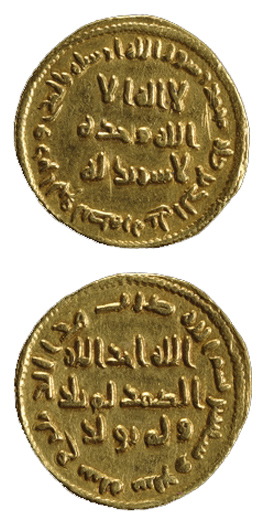
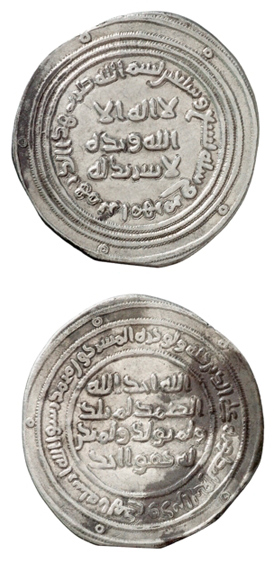
May Allah bless the muslim ummah and save us from shirk, kufr and bidat.
And Allah knows best...
Tahmeed
Main source:
http://www.islamic-awareness.org/History/Islam/Coins/